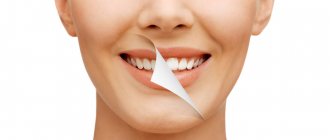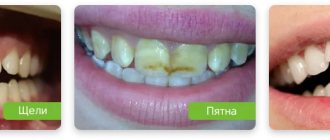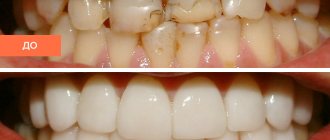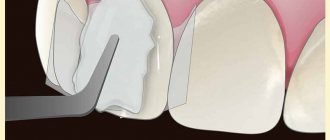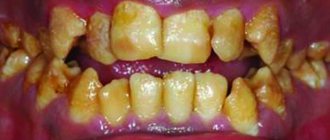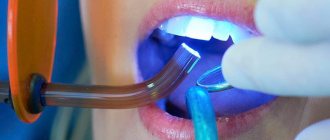Content:
- Fluoride varnish
- Why use a fluoride-based protectant?
- Contraindications to the use of fluorine-containing varnishes
- Is it possible to use varnish at home?
- Carrying out the procedure in a dental clinic
- Important nuances
Enamel is the hardest tissue of the human body, but even it becomes thinner over time under the influence of a huge number of different factors.
The procedure of protective coating of teeth with a special varnish allows you to protect the outer shell of the unit and make it more durable. In addition, dental compounds used to treat the teeth of children and adults are a kind of antiseptics. They block the spread of pathogens and thus provide reliable caries prevention.
Most often, when providing a protective coating for teeth, dentists use fluoride varnish. This is a special viscous liquid, including fluorine and other related compounds.
Benefit
As already mentioned, the main goal of fluoridation is to strengthen tooth enamel. In addition, there are other advantages of this procedure:
- The sensitivity of the teeth is reduced, so there is no discomfort when consuming cold and hot food or drinks.
- The risk of developing caries is reduced due to a reduction in the number of pathogenic bacteria and increased resistance of teeth to an acidic environment.
- Fluoridation prevents calcium from being washed out of tooth enamel, making teeth stronger and stronger.
Fluoride varnish
The composition of the varnish, which protects tooth enamel and prevents calcium leaching, includes:
- sodium fluoride;
- shellac;
- fir balsam;
- chloroform;
- ethyl alcohol, etc.
All these substances act in synergy - they provide high-quality disinfection of the treated surface and effectively strengthen it. When enamel comes into contact with sodium fluoride, a hard protective layer is formed. It is thanks to him that the unit ceases to be overly sensitive to salty, spicy and sour foods, and temperature changes.
The mixture has a positive effect on the condition of the gums. After its use, soft tissues become less inflamed and bleed less.
What is dental fluoridation?
Fluoridation of teeth is a type of therapeutic effect on the surface of teeth, which helps strengthen them and prevents the development of many diseases.
This procedure is indicated both for thinning tooth enamel and as a prevention of caries. In the process of its implementation, various types of medicinal compositions are used. All of them enrich tooth enamel with fluoride ions - the most important mineral responsible for the strength and longevity of teeth. Regular fluoridation of enamel reliably protects teeth from the negative effects of acidic environments and harmful bacteria. First of all, fluoridation of enamel is recommended:
- Persons with increased tooth sensitivity;
- With a high risk of developing caries.
The procedure is absolutely painless, so it can be performed even on the youngest patients.
Why is tooth enamel destroyed?
The main cause of enamel destruction is the accumulation of organic acids in the oral cavity. Weakened, or demineralized, enamel is unable to withstand environmental risk factors. This inevitably leads to bacteriological contamination and increased sensitivity of the teeth.
Causes of enamel demineralization:
- Unhealthy diet;
- Low fluoride content in drinking water;
- Lack of calcium in the body;
- Pathogenic microorganisms in the oral cavity;
- Violations of the chemical composition of saliva;
- Negative impact of external factors;
- Insufficient oral care;
- Age-related changes.
These factors affect the condition of the oral cavity and the strength of tooth enamel. Weakened enamel is not able to fight the proliferation of cariogenic bacteria. The interaction of microorganisms that make up dental plaque leads to the formation of a carious lesion. This means that microdefects appear on the enamel surface. Prolonged neglect of demineralization will result in the stronger layers of enamel being affected over time. As a result, a comfortable environment is created for the proliferation of pathogenic bacteria and accelerated tooth decay.
Fluoridation of tooth enamel will help stabilize the condition and compensate for the lack of minerals.
What is fluoridation of teeth?
There are several methods of fluoride prevention of dental caries. The optimal solution would be the integrated use of a systemic and local source of fluoride, since the isolated use of one method may be insufficient.
Types of fluoridation:
- Drinking fluoridated drinking water;
- Fluoride tablets;
- Cleaning your teeth with a toothpaste containing fluoride;
- Simple fluoridation;
- Deep fluoridation.
Systematic consumption of fluoride-enriched water increases the concentration of fluoride ions in saliva and the oral cavity. This can compensate for the deficiency of fluoride in dental plaque and in the upper layers of enamel. However, in cases of severe demineralization, oral fluoride prophylaxis may not be sufficient. There are frequent cases of caries among adolescents, since external drugs are not able to penetrate thick layers of plaque.
Simple fluoridation of teeth
Simple fluoridation is carried out in the clinic in two ways:
1. Gel fluoridation course;
Before the procedure, the dentist removes plaque from the surface of the teeth and isolates the tooth surface from saliva using cotton pads. A special mouthguard that follows the shape of the teeth is filled with fluoride-containing gel and applied to the surface of the teeth for 5-10 minutes. Then the excess drug is removed from the oral cavity. After completing the procedure, you should refrain from drinking and eating for two hours.
In order for fluoride ions to penetrate the tooth enamel as deeply as possible, it is recommended to undergo the procedure up to 10-15 times (as prescribed by the doctor). The course should be repeated every six months.
2. Strengthening the enamel with sealing varnish.
Prolongs the effect of enamel fluoridation. The dentist cleans and dries the surface of the teeth. The varnish is applied with a brush to the surface of the enamel from the inside and outside and dried again. After which it hardens on the teeth, forming a fluoride-sealing film on the enamel, which remains in the areas of demineralization for up to several weeks. After applying fluoride varnish, it is not recommended to eat solid food or brush your teeth for 12-24 hours. Even a single application of varnish increases the concentration of fluoride in enamel by up to 77%. The procedure is painless and effective for children. The frequency of repetition depends on individual indicators and is determined by the attending physician. In most cases, this is 2 times every six months.
However, despite a noticeable reduction in karyotic formations, simple fluoridation is effective only for superficial damage to the enamel. In order for calcium fluoride to penetrate deep into the enamel, the deep fluoridation method is used.
Why use a fluoride-based protectant?
Fluoridation is prescribed to young children to avoid tooth decay. After all, it is very important to keep the milk units healthy until they are replaced. How many years the molars will last largely depends on their condition.
Other indications for enamel coating include:
- Restoration of the natural mineral structure of hard tissues. Fluorine is able to “pull” the necessary minerals from saliva, due to which an active saturation reaction occurs.
- Prevention of premature crown wear. If the tooth is healthy, the problem of abrasion will not arise, so you need to monitor the condition of its tissues.
- High sensitivity. It can be hereditary or provoked by rough mechanical influences performed by dental procedures (for example, whitening).
- Wedge-shaped defect. With this diagnosis, tissue is destroyed in the cervical area. Moreover, the destructive process is in no way related to caries.
It is advisable to cover your teeth with a protective coating after professional ultrasonic cleaning. In general, this procedure will be useful to almost all patients of the dental clinic (with the exception of those who have contraindications to its implementation).
Fluoridation and silvering: what is the difference?
The silvering method is the treatment of teeth with preparations containing silver nitrate. This method of combating caries is prescribed to the youngest children - up to 3 years old. The procedure is quick and painless: saliva is removed from baby teeth, then they are impregnated with a silver preparation. Silvering is used only at the initial stage of caries - “white spots”, and can stop the development of the disease, but does not cure it. In addition, a big disadvantage is the darkening of the teeth as a result of the procedure.
In dentistry, this method is now almost never used, giving way to a more effective fluoridation technique. The procedure is as simple as silvering, but it has advantages over the latter: fluoridation not only prevents the development of caries, but also strengthens tooth enamel.
Is it possible to use varnish at home?
It is allowed to carry out a strengthening procedure at home, but you should still consult a doctor first. Difficulties will arise already at the stage of purchasing varnish - you won’t be able to find a high-quality and safe solution on the open market. It must be ordered from a dental center or specialized medical store.
If you do find a drug and the dentist allows you to use it yourself, do not forget about the rules:
- pre-dry your teeth using cotton swabs;
- apply the product in a very thin layer;
- The varnish should dry naturally for about 5 minutes;
- Do not eat anything for twelve hours after the procedure.
Correction of crooked teeth
As a rule, such a defect can be corrected using an artistic method only in case of minor deviations from the norm.
In case of protruding units, crowding or partial rotation, the patient is first sent to the orthodontist for a consultation. It is quite possible that the installation of braces or aligners will be initially recommended, and only after a course of treatment does it make sense to return to the issue of restoring aesthetics. Correction of malocclusion or dentition disorders can be successfully corrected at any age, including adults. Dentika specialists select the best option, taking into account the main task, the wishes of clients and the individual characteristics of the dental system. Modern dentistry carries out the restoration of front teeth in various ways, which allows restoration of any degree of complexity.
Carrying out the procedure in a dental clinic
Dental treatment in a dental clinic is much more effective than at home.
Before proceeding with the manipulation, the doctor carefully cleans the dental crowns from hard stone and soft plaque. Due to this, the fluoridated gel adheres better to the enamel and penetrates into its deeper layers. Afterwards, the work area is isolated from saliva. This is very important and a person is not able to do this on his own. The dentist then uses fluoride varnish. He carefully distributes it over all surfaces, making sure that not a single area is left untouched. Until the solution dries, the person sits with his mouth open.
An experienced dentist knows exactly how much varnish to use and how to apply it correctly. Therefore, the patient does not risk anything. He can be confident in the effectiveness of the therapy.
Important nuances
In order for the use of a fluoride-containing product to be effective, it is important to remember some points:
- After manipulation, it is prohibited to use pastes containing fluoride. This leads to an excess of the component in the body and causes the development of fluorosis.
- Treatment can only be carried out according to medical prescription. Between procedures, intervals determined by the dentist on an individual basis should be maintained.
- Pregnant women are recommended to strengthen their enamel with fluoride. During this period, calcium is actively washed out of the expectant mother’s body. To keep it in your teeth, you need to coat them with varnish. But in case of severe toxicosis, fluoridation is strictly contraindicated.
- Fluoride varnish should be applied after removing braces, during breastfeeding, and after gum disease.
The manipulation can be performed for the first time when the child turns two years old. Then it is done according to indications. Adults should use a fluoride-containing composition at least once a year, immediately after professional oral hygiene.
Stages of the procedure
Regardless of the chosen fluoridation method, this procedure includes the following steps:
- Oral hygiene. This can be either a full professional cleaning (removal of plaque and tartar), or a simple treatment with antiseptic dental compounds. The tooth surface must be clean before applying fluoride-containing compounds so that the mineral substances can protect the enamel.
- Thorough drying with warm air.
- Depending on the chosen method of fluoridation, either fluoride-containing varnish is applied to the teeth, or a mouth guard with a special paste is put on for 10-15 minutes.
- During deep fluoridation, the surface of the teeth is covered with an enamel-sealing liquid, which is thoroughly dried and carefully shaded. After 1-2 minutes, rinse the oral cavity.
It is also important to understand that fluoridation is advisable only on healthy teeth, so before the procedure it is imperative to sanitize the oral cavity.
Prof. hygiene with 20% discount
Moscow
